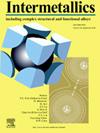Corrosion and wear behavior of the Fe-based amorphous coating in extremely aggressive solutions
IF 4.3
2区 材料科学
Q2 CHEMISTRY, PHYSICAL
引用次数: 0
Abstract
Fe-based amorphous coatings (Fe-based AMCs) are a cost-effective solution for improving the corrosion and wear protection performance of high-end equipment seals operating under various harsh operating environments. However, relatively little research has been done to demonstrate how coating microstructural defects affect the protective performance of the passive film and how corrosion ions control the degree of wear interface response. Herein, Fe-based AMCs with various microstructures were prepared using detonation spraying under different spraying parameters, and the resultant coatings were named as Fe-based AMC-A, B and C. The corrosion and wear behaviors of the resulting coatings were assessed using the electrochemical corrosion and wear test in 1 mol/L NaCl, 1 mol/L H2SO4 and 1 mol/L NaOH. The results show that the corrosion and wear performance of Fe-based AMCs is directly influenced by their microstructures and the wear interface interactions between the tribopairs. The heterogeneous distribution of chemical components caused by pores and crystalline phases could reduce the corrosion resistance of the coating. Fe-based AMC-B has the highest corrosion potential (−389 mV) and lowest corrosion current density (3.088 × 10−6 A cm−2). Hydrogen ion enrichment accelerates the anodic polarization and hydration reaction of Si3N4 ball, whereas high concentrations of hydroxide ions have the opposite effect. Because of the high degree of hydration reactions and high content of MoO3, the friction coefficient (0.34 ± 0.01) and wear rate (6.94 × 10−6 mm3 N−1 m−1) of the coating were lowest in the acidic solution, while the friction coefficient (0.63 ± 0.02) and wear rate (27.8 × 10−6 mm3 N−1 m−1) of the coating in the NaOH solution were highest compared to that in H2SO4 and NaCl solutions. The wear mechanisms of the coating in corrosive solutions can be understood with tribo-chemical wear and corrosion wear.
求助全文
约1分钟内获得全文
求助全文
来源期刊

Intermetallics
工程技术-材料科学:综合
CiteScore
7.80
自引率
9.10%
发文量
291
审稿时长
37 days
期刊介绍:
This journal is a platform for publishing innovative research and overviews for advancing our understanding of the structure, property, and functionality of complex metallic alloys, including intermetallics, metallic glasses, and high entropy alloys.
The journal reports the science and engineering of metallic materials in the following aspects:
Theories and experiments which address the relationship between property and structure in all length scales.
Physical modeling and numerical simulations which provide a comprehensive understanding of experimental observations.
Stimulated methodologies to characterize the structure and chemistry of materials that correlate the properties.
Technological applications resulting from the understanding of property-structure relationship in materials.
Novel and cutting-edge results warranting rapid communication.
The journal also publishes special issues on selected topics and overviews by invitation only.
 求助内容:
求助内容: 应助结果提醒方式:
应助结果提醒方式:


